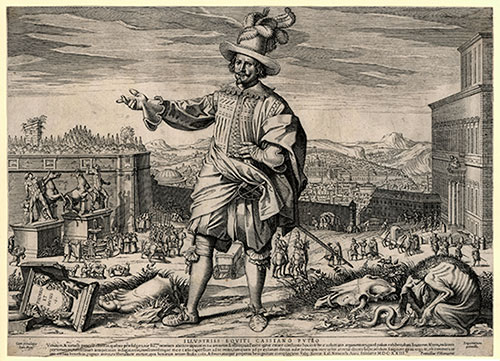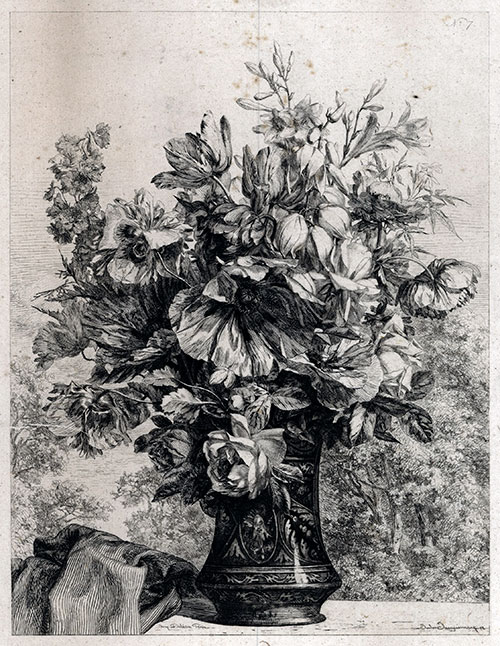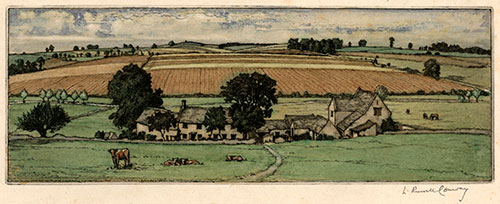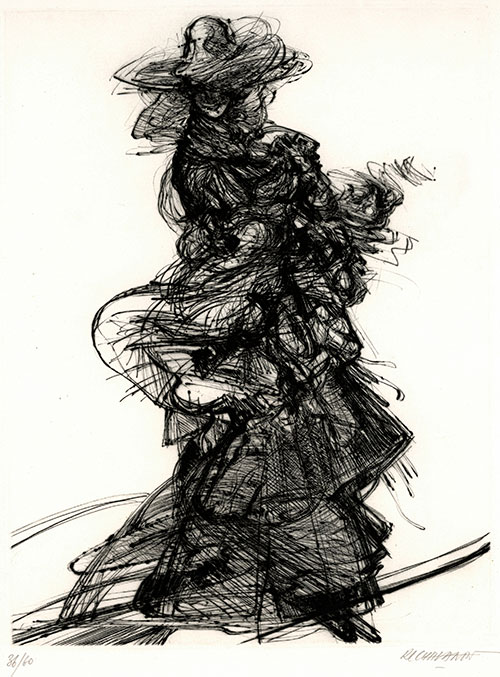The
Home Page Selection
If
you require further information on any
print featured here, please contact
us.
When
a print has been sold it will be marked
as Sold.
A
growing archive of selections
from previous Home pages is featured in
the
Home
Page Selection Archive |
|
See
also :
Click
on a thumbnail (left)
to link directly with the entry for that
print, or scroll down to view all the selected
prints from the current Home
Page.
Images
are not to relative scale (see stated dimensions) and also at only modest resolution.
If you wish to view extracts of an image at higher resolution, please Contact us.
|
|
|
|

| |
FRANCESCO VILLAMENA
Assisi c1565 – 1624 Rome
An engraver, designer, drawing teacher, collector and dealer in antiquities, Villamena settled in Rome 1585-90. In 1596 the Pope granted him a ten year papal privilege (copyright) on all the future prints he produced and published.
A printing press was among his possessions when he died.
Portrait of Ioannem Altum (Johann Alten), Swiss Guard, pointing out the antiquities of Rome
Nagler 64;
Kühn-Hattenhauer Das graphische Oevre von Francesco Villamena pp 137-40
376 x 519 mm
Original engraving, 1623.
The plate signed and dated.
Published by Villamena, with his privilege.
A fine impression, trimmed on or fractionally into the plate.
With a repaired tear.
£3000
The preliminary drawing is in the British Museum.
Standing on the Quirinal , near the Horse tamers, and with a distant view of St Peters and the Vatican,
Johannes Alten (or Alt) is dressed in the uniform of a warrant-officer of the Swiss Guard.
He hailed from Luzern and was a highly regarded student of antiquity and a guide (ciceroni) for German speaking visitors to Rome. He is standing on the Quirinal with a panoramic view of Rome beyond, including a view of St Peter’s and the Vatican.
Villamena dedicated the print to Cassiano dal Pozzo, the greatest art patron and collector of his day (and a godfather to Villamena’s children).
A large part of Pozzo’s collection was bought by George III and is in the Royal Library at Windsor. A number of volumes containing prints passed to the British Museum.
An exhibition entitled The Paper Museum of Cassiano Dal Pozzo was organised by the Print Room in Print Room in 1993.
Return to top ^ |
|
|
|

|
|
EDWARD CALVERT
Appledore, near Bideford 1799 – 1773 London
After five years in the Navy, Calvert studied art in Plymouth, before attending the Royal Academy Schools in London in 1824.
Even before Calvert met Palmer and joined the Brotherhood of the Ancients around Blake, he was already influenced by the older artist. He probably owned a copy of Dr Thornton’s 3rd edition of The Pastorals of Virgil … published in 1821, which included Blake’s only wood engravings, and certainly bought Blake’s Job, illustrated with copper line engravings, in Plymouth in 1823.
A drawing in the British Museum, The Primitive City, annotated with the date 1822, has a classical draped nude (Calvert collected antique gems) very reminiscent of the figure of the Bride, and also includes a group of sheep. The drawing anticipates the format, imagery and intense visionary pastoral poesy of Calvert’s Shoreham period prints.
These miniature wood and copper line engravings, produced 1827-1831, are the height of his artistic achievement. At this period, though he might engrave a publication line, as on The Bride, Calvert only issued a few proofs for friends.
The Bride
Lister 8 c
113 x 163 mm
Original engraving, 1828.
Signed in the plate within the image and ‘entitled’ below
O God, thy Bride seeketh Thee. A Stray Lamb is led to thy Folds.
Dated in Calvert’s publication line, though the engraving was not formally published till later.
From the first issue, in 1893, in A Memoir, written by Calvert’s son, edition of 350.
Printed in brown-black ink on stout cream wove, trimmed in the top and bottom margins.
A small pale stain in the right margin just outside the platemark.
Sold
The Tate Gallery commentary on the engraving reads
Calvert's landscapes were partly inspired by the countryside around Shoreham. But they also drew
on the pastoral vision depicted by Blake in his Virgil woodcuts and on Blake's notion of Beulah.
This came from the Biblical Beulah, the name given to Palestine when God restored it to favour,
and from John Bunyan's Beulah or Earthly Paradise of The Pilgrim's Progress. Beulah also meant
'married'.
The idea of the Soul as the Bride seeking God on the difficult path to salvation lies at the heart
of The Bride.
Return to top ^ |
|
|
|
 |
|
JULES JACQUEMART
Paris 1837 – 1880 Paris
The son of an art collector, Jacquemart was self-taught as an etcher.
Most of his etchings record art objects or curiosities, or reproduce paintings,
and Béraldi, in the introduction to his catalogue of Jacquemart’s etchings
describes him as one of the most astonishing etchers of all time, creator of a new genre le rendu des objets d’art.
Many of these etchings were published in the Gazette des Beaux Arts, which also included the Gonse catalogue, the basis of Béraldi’s, both in the Gazette and as a separate book.
From his earliest plates, 1859, Jacquemart also made original etchings
and was a member of the Société des Aquafortistes.
His masterpieces were the series of eight plates of flowers, including the title (pl.1),
Huit Etudes et Compositions de Fleurs, published by Cadart in 1862.
(Study of Flowers in a Maiolica Vase with scrolling acanthus and mask decoration)
Gonse/Béraldi 324 probably ii/iii
291 x 224 mm
Original etching, 1862.
The plate signed and dated.
Printed by Delâtre.
With the plate No. 7 at the top right.
A proof on tissue-thin japan, with related cockling and other defects, some foxing and a printing crease.
Stamped at the foot of the sheet with Et.3731.
Sold
Return
to top ^ |
|
|
|
 |
|
L RUSSELL CONWAY
Wimbledon, London, 1882 - 1948 London
A painter, etcher and illustrator Leonard Russell Conway trained at the Slade.
He served as a captain in the First World War and fought in the Dardanelles with the 5th Battalion Essex Regiment. He had an article, with sketches of Gallipoli, published in The Field magazine in 1916, sketches which the Imperial War Museum subsequently acquired.
Post the War, Conway ‘titled’ his etchings in the plate in miniscule script and also began to hand-colour some impressions.
Landscape in the Cotswolds -
View from White Hill, near Burford in Oxfordshire, May 1928 from a sketch Sep 1927
92 x 253 mm
Original etching, 1928, hand-coloured by the artist in watercolours.
The plate signed and inscribed at the foot.
Signed in pencil.
On cream laid paper, backed with thin japan, wrinkled in places, supporting a tear in the sky.
Sold
Return
to top ^ |
|
|
|
 |
|
DAVID LUCAS
Geddington Chase, Northamptonshire 1802 – 1881 Fulham Workhouse
A chance encounter in 1820 with the mezzotint engraver Samuel William Reynolds
led Lucas to move to London as an apprentice.
In 1827 he began to work on his own and in 1829 met Constable, who employed him to engrave the plates for his Various Subjects of Landscape, Characteristic of English Scenery, which Constable published in Parts, 1830-32, as the individual plates were finished.
Constable (1776 -1837) made oil sketches for the series and he and Lucas worked in close collaboration through developing progress proofs.
Lucas, is only known for his Constable mezzotints, and continued to produce works after Constable’s death. Constable’s friend and biographer C R Lesley selected the paintings,
and checked the progress proofs as Constable had done.
Lucas published these, in the same format, himself in 1846, as Mr David Lucas’s New Series of Engravings, Illustrative of English Landscape, from Pictures of John Constable R.A.
The Fitzwilliam owns a note from Lesley which expresses his admiration for Lucas’ engraving skills.
I have most carefully compared all the plates, during their process, with the pictures
from which they are taken, and have witnessed the great skill and assiduity
by which Mr Lucas has rendered them accurate and tasteful translations to a degree
not to be expected from any other hand. His long and close intimacy with the painter,
and the great number of works which he executed under his immediate direction, some
which subjects of extreme difficulty, and large dimensions, gave him an insight into
the principles of Constable’s art, and enabled him to imbibe its spirit, to a degree
entirely unattainable under less favourable circumstances.
Stratford Mill
Shirley 38 i/ii, Progress proof b
390 x 495 mm (plate); 293 x 421 mm (image)
Mezzotint after Constable, begun 1834.
A proof before all letters.
A pencil inscription at the foot of the sheet of chine, Young Waltonians.
On chine appliqué on wove.
A fine rich impression, but time stained and with some foxing. Other defects in the margins of the chine.
The wove sheet with large margins.
£1500
Work on the plate ceased at the end of 1834, though by then the plate was fully composed, perhaps due to a temporary quarrel between artist and engraver.
Lucas added the lettering, including the title The Young Waltonians (after Isaac Walton’s The Compleat Angler) after Constable’s death and published it in 1840.
Constable painted Stratford Mill in 1820 for exhibition at the Royal Academy that summer. It is the second in the series of ‘six-footers’ depicting working scenes on the River Stour. It is now in the National Gallery. The full size preparatory oil sketch is in the Yale Centre for British Art and was developed from a small oil of 1811 of children fishing near the mill.
The scene is Stratford St Mary, about two miles west of East Bergholt.
In Constable’s day Stratford mill was a water-powered paper mill.
Return
to top ^ |
|
|
|
 |
|
ROGER-LOUIS CHAVALON
Roanne 1937 – 2010 Paris
Chavanon was a French painter, engraver, sculptor and medallist.
As a child of seven his drawing skills were recognised by his school teacher
who suggested he attend the Art School in Saint Etienne, as soon as he was fifteen.
He studied there for five years and then moved to Paris, where he became art director
for an advertising company; he did a disc cover for Bob Dylan among others.
When Chavalon married, his wife encouraged him to work independently as a creative artist.
As a medallist he had a contract with La Monnaie, the Paris mint.
As a sculptor, he is known for his bronze bust of Marianne (figure symbolic of the French Republic since the Revolution) produced in 1989 for the bi-centenary of the French Revolution, which was unveiled in the famous Café de la Paix in Paris, before casts were circulated to all the mayors’ offices of France. His statue of Europa is in the European Parliament in Luxemburg collection.
As a printmaker Chavalon worked both in drypoint and lithography.
La Parisienne
392 x 296 mm
Original drypoint, c1979.
Signed in pencil and numbered 36/60.
On Arches wove paper.
Sold
Return
to top ^ |
|
|
|
|
|
|
|